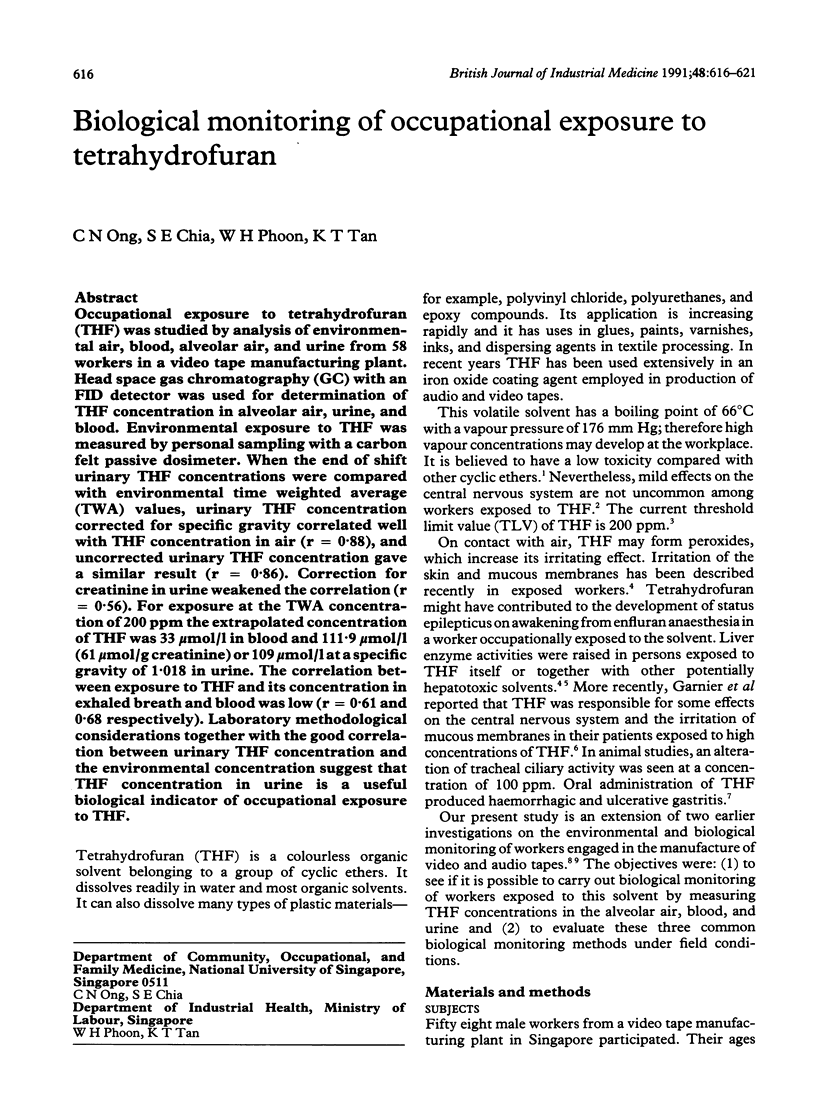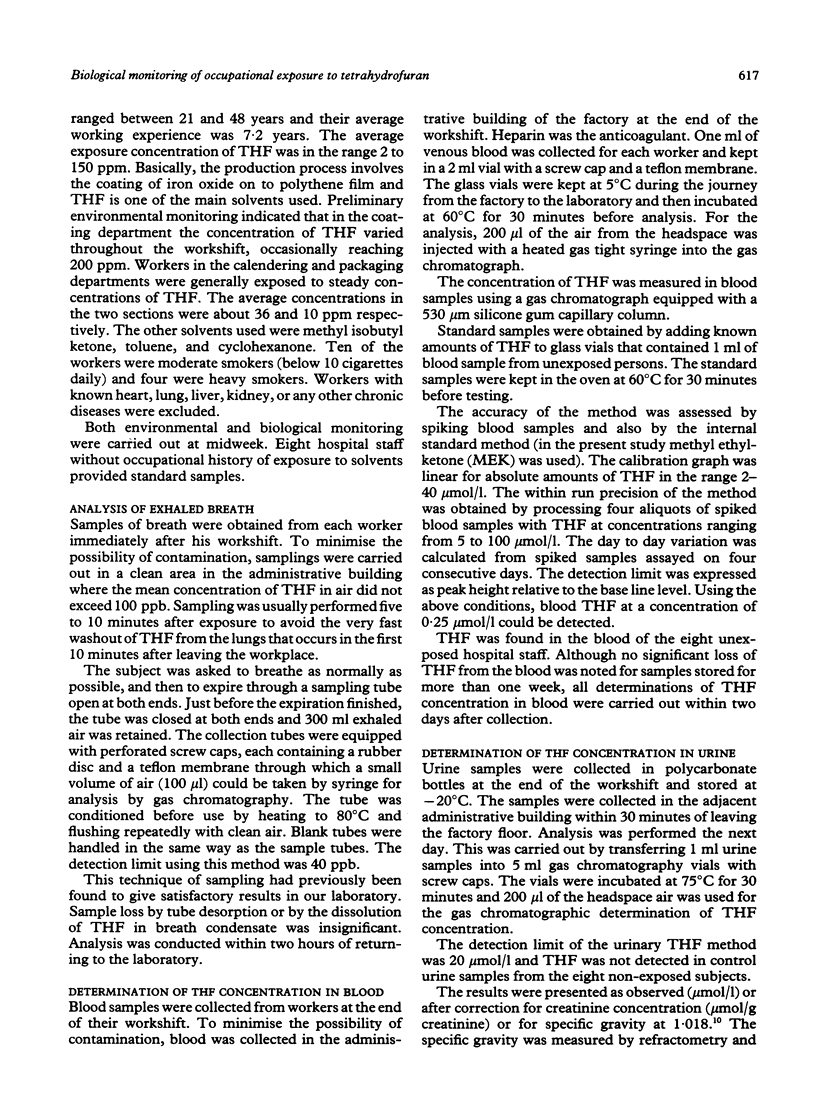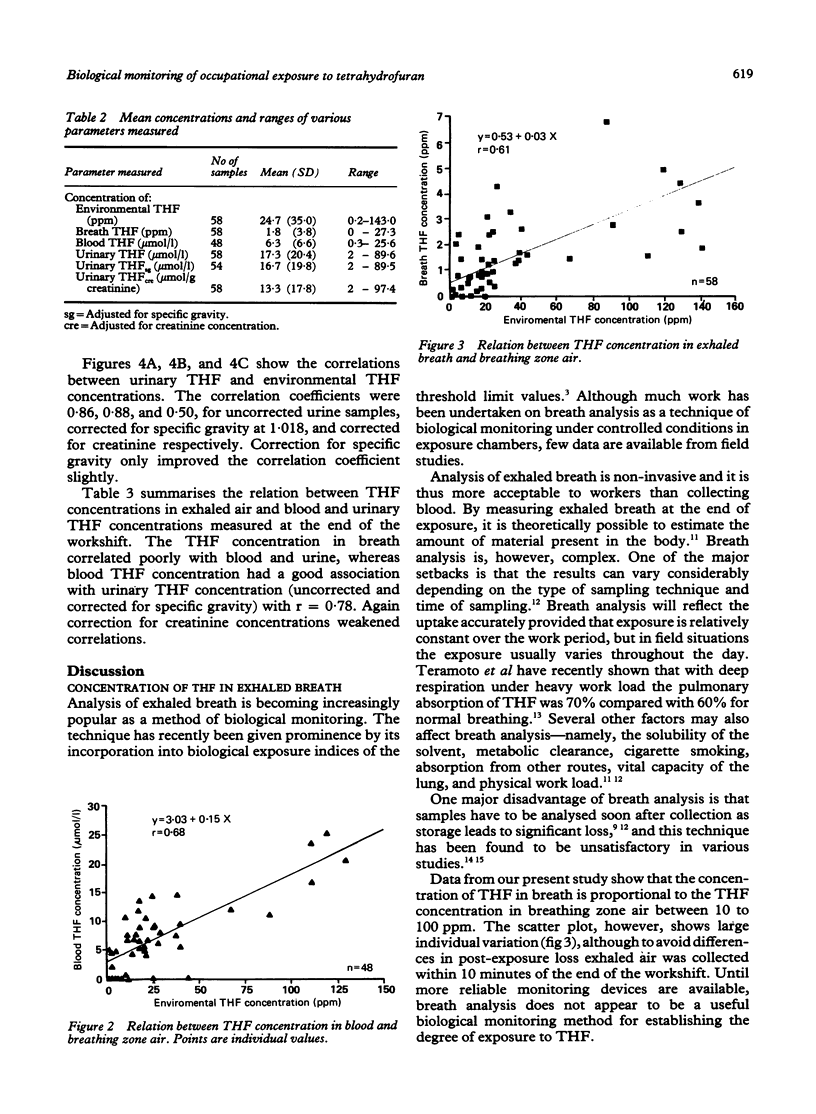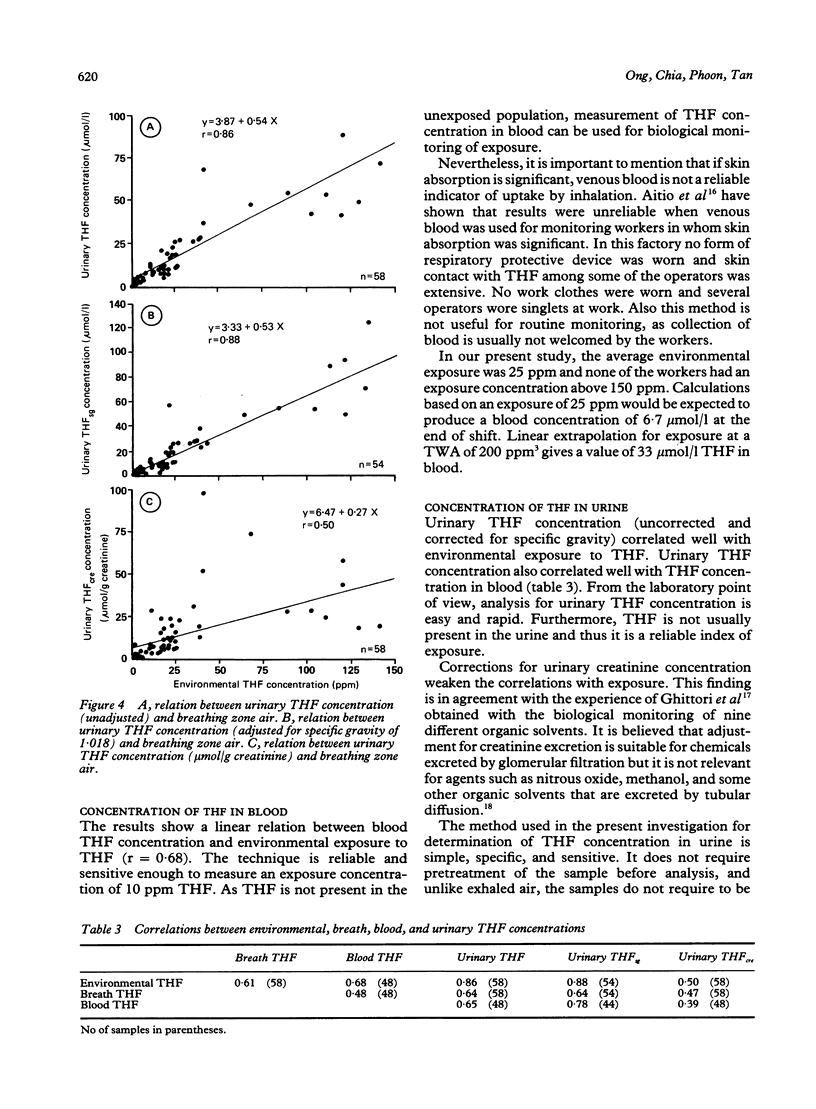Abstract
Occupational exposure to tetrahydrofuran (THF) was studied by analysis of environmental air, blood, alveolar air, and urine from 58 workers in a video tape manufacturing plant. Head space gas chromatography (GC) with an FID detector was used for determination of THF concentration in alveolar air, urine, and blood. Environmental exposure to THF was measured by personal sampling with a carbon felt passive dosimeter. When the end of shift urinary THF concentrations were compared with environmental time weighted average (TWA) values, urinary THF concentration corrected for specific gravity correlated well with THF concentration in air (r = 0.88), and uncorrected urinary THF concentration gave a similar result (r = 0.86). Correction for creatinine in urine weakened the correlation (r = 0.56). For exposure at the TWA concentration of 200 ppm the extrapolated concentration of THF was 33 mumol/l in blood and 111.9 mumol/l (61 mumol/g creatinine) or 109 mumol/l at a specific gravity of 1.018 in urine. The correlation between exposure to THF and its concentration in exhaled breath and blood was low (r = 0.61 and 0.68 respectively). Laboratory methodological considerations together with the good correlation between urinary THF concentration and the environmental concentration suggest that THF concentration in urine is a useful biological indicator of occupational exposure to THF.
Full text
PDF





Selected References
These references are in PubMed. This may not be the complete list of references from this article.
- Aitio A., Pekari K., Järvisalo J. Skin absorption as a source of error in biological monitoring. Scand J Work Environ Health. 1984 Oct;10(5):317–320. doi: 10.5271/sjweh.2323. [DOI] [PubMed] [Google Scholar]
- Campbell L., Marsh D. M., Wilson H. K. Towards a biological monitoring strategy for toluene. Ann Occup Hyg. 1987;31(2):121–133. doi: 10.1093/annhyg/31.2.121. [DOI] [PubMed] [Google Scholar]
- Droz P. O., Guillemin M. P. Occupational exposure monitoring using breath analysis. J Occup Med. 1986 Aug;28(8):593–602. doi: 10.1097/00043764-198608000-00014. [DOI] [PubMed] [Google Scholar]
- Edling C. Interaction between drugs and solvents as a cause of fatty change in the liver? Br J Ind Med. 1982 May;39(2):198–199. doi: 10.1136/oem.39.2.198. [DOI] [PMC free article] [PubMed] [Google Scholar]
- Elovaara E., Pfäffli P., Savolainen H. Burden and biochemical effects of extended tetrahydrofuran vapour inhalation of three concentration levels. Acta Pharmacol Toxicol (Copenh) 1984 Mar;54(3):221–226. doi: 10.1111/j.1600-0773.1984.tb01921.x. [DOI] [PubMed] [Google Scholar]
- Garnier R., Rosenberg N., Puissant J. M., Chauvet J. P., Efthymiou M. L. Tetrahydrofuran poisoning after occupational exposure. Br J Ind Med. 1989 Sep;46(9):677–678. doi: 10.1136/oem.46.9.677. [DOI] [PMC free article] [PubMed] [Google Scholar]
- Ghittori S., Imbriani M., Pezzagno G., Capodaglio E. The urinary concentration of solvents as a biological indicator of exposure: proposal for the biological equivalent exposure limit for nine solvents. Am Ind Hyg Assoc J. 1987 Sep;48(9):786–790. [PubMed] [Google Scholar]
- Ikeoka H., Ohashi Y., Maruoka K., Nakata J., Masutani H., Nakai Y., Horiguchi S., Teramoto K. Effects of tetrahydrofuran exposure on the ciliary activity and morphology of tracheal epithelium in rabbits. Osaka City Med J. 1984 Jun;30(1):53–67. [PubMed] [Google Scholar]
- Juntunen J., Kaste M., Härkönen H. Cerebral convulsion after enfluran anaesthesia and occupational exposure to tetrahydrofuran. J Neurol Neurosurg Psychiatry. 1984 Nov;47(11):1258–1258. doi: 10.1136/jnnp.47.11.1258. [DOI] [PMC free article] [PubMed] [Google Scholar]
- Miyasaka M., Kumai M., Koizumi A., Watanabe T., Kurasako K., Sato K., Ikeda M. Biological monitoring of occupational exposure to methyl ethyl ketone by means of urinalysis for methyl ethyl ketone itself. Int Arch Occup Environ Health. 1982;50(2):131–137. doi: 10.1007/BF00378075. [DOI] [PubMed] [Google Scholar]
- Money C. D., Gray C. N. Exhaled breath analysis as a measure of workplace exposure to benzene ppm. Ann Occup Hyg. 1989;33(2):257–262. doi: 10.1093/annhyg/33.2.257. [DOI] [PubMed] [Google Scholar]
- Ong C. N., Sia G. L., Chia S. E., Phoon W. H., Tan K. T. Determination of cyclohexanol in urine and its use in environmental monitoring of cyclohexanone exposure. J Anal Toxicol. 1991 Jan-Feb;15(1):13–16. doi: 10.1093/jat/15.1.13. [DOI] [PubMed] [Google Scholar]
- Perbellini L., Faccini G. B., Pasini F., Cazzoli F., Pistoia S., Rosellini R., Valsecchi M., Brugnone F. Environmental and occupational exposure to benzene by analysis of breath and blood. Br J Ind Med. 1988 May;45(5):345–352. doi: 10.1136/oem.45.5.345. [DOI] [PMC free article] [PubMed] [Google Scholar]
- Pezzagno G., Ghittori S., Imbriani M., Capodaglio E. Urinary elimination of styrene in experimental and occupational exposure. Scand J Work Environ Health. 1985 Oct;11(5):371–379. doi: 10.5271/sjweh.2210. [DOI] [PubMed] [Google Scholar]
- Pezzagno G., Imbriani M., Ghittori S., Capodaglio E., Huang J. Urinary elimination of acetone in experimental and occupational exposure. Scand J Work Environ Health. 1986 Dec;12(6):603–608. doi: 10.5271/sjweh.2096. [DOI] [PubMed] [Google Scholar]
- Sedivec V., Mráz M., Flek J. Biological monitoring of persons exposed to methanol vapours. Int Arch Occup Environ Health. 1981;48(3):257–271. doi: 10.1007/BF00405613. [DOI] [PubMed] [Google Scholar]


